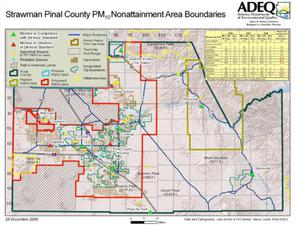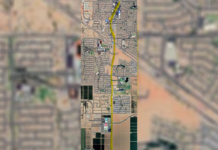
Details about a plan to clean up the air expanded on a hot-button issue at Wednesday night’s public hearing on a proposed non-attainment area map for the dangerous particle PM10.
Ira Domsky, the acting director of air quality for the Arizona Department of Environmental Quality, led the hearing that included a diverse crowd of residents, air-quality experts and businessmen from all over Pinal County.
This hearing focused on the EPA’s letter to Arizona Governor Jan Brewer, which arrived on her desk in December. The letter marks the official beginning of a timeline of activity that will culminate in a comprehensive plan to deal with Pinal County’s air-quality issues.
Domsky delivered a detailed Power Point presentation that included maps, statistics, data charts, and hard facts about Pinal County’s air pollution problem. One map of particular interest to many in attendance pinpointed a plan by the ADEQ to lower the amount of air pollution within the county.
“The EPA takes the governor’s recommendation and establishes the boundaries by regulation.” Domsky said. “Once the non-attainment area is established, we have 18 months to put a plan together to show how within three years we will achieve healthful air.” Domsky also talked about Arizona’s high rate of asthma and the dangers of breathing in what is known as PM10.
So what is PM10 and where does it come from? PM10 is essentially tiny particles made up of dust and dirt from unpaved roads, vacant lots, construction sites and cattle lots. The Environmental Protection Agency, which tracks air quality across the country, has defined the particle mix in most U.S. cities as made up of fine particles (less than 2.5 micrometers in diameter or PM2.5) generated by combustion sources, with smaller amounts of coarse dust (between 2.5 and 10 micrometers in diameter or PM10), all of which are smaller than the width of a human hair.
Issues of air quality in Pinal County have been apparent for years. The EPA has eight monitoring stations in the county. Pinal County has the unwelcome honor of having five of the top eight meters for poorest air quality. The Cowtown meter, located in Maricopa, is the most active in the United States with nearly 222 days a year in violation. For comparison, the next closest meter has 49 days per year.
The data obtained from the monitors was used by the ADEQ to develop the boundaries on the map where areas are most affected by air pollutants. Domsky says there are some parts of Pinal County that do not include air pollutants.
“We don’t want to declare the entire county as non-attainment, which is where the EPA started with all this.” Domsky said. “There is the ability to do an analysis of a number of different factors to identify an area that should be larger, or, in our case, it’s smaller, and we want to make sure we get all the areas that are contributing to non-attainment as well as the areas of where we measure the violations and standards.”
Domsky says there are many different factors that go into determining how the map is formed including: air-quality data, emission sources, population, urbanization, meteorology, topography, geography and traffic patterns. All of these factors go into what is called a technical support document that is included as part of the recommendation that is submitted to the governor.
The recommendation is still in the final stages of being completed by the ADEQ. The next hearing will be held in on Feb. 1 in Florence at the Emergency Operations Center, Building F, 31 N. Pinal Street. The purpose of this meeting is to receive public comments on the draft Technical Support Document and Strawman boundaries for PM10 and PM2.5 non-attainment areas.
To listen to the entire meeting, click the arrow below. As you listen, you can view Domsky’s Power Point presentation here.
1-20-10 Pinal PM10 PM2 5 Stakeholder Mtg
Submitted map

![O’Reilly gears up for second Maricopa location An exterior view of O'Reilly Auto Parts on John Wayne Parkway on May 2, 2024.[Monica D. Spencer]](https://www.inmaricopa.com/wp-content/uploads/2024/05/spencer-050224-oreilly-second-location-web-218x150.jpg)
![Province writer opens the athlete’s mind in new book Tom Schuman, a Province resident, poses with a copy of his new book, "My Wide World of Sports," outside his home on May 2, 2024. [Monica D. Spencer]](https://www.inmaricopa.com/wp-content/uploads/2024/05/spencer-050224-tom-schuman-sports-book-web-01-218x150.jpg)








![City gave new manager big low-interest home loan City Manager Ben Bitter speaks during a Chamber of Commerce event at Global Water Resources on April 11, 2024. Bitter discussed the current state of economic development in Maricopa, as well as hinting at lowering property tax rates again. [Monica D. Spencer]](https://www.inmaricopa.com/wp-content/uploads/2024/04/spencer-041124-ben-bitter-chamber-property-taxes-web-218x150.jpg)

![Maricopa restaurateur makes Food Network connection [Namkeen Dhaba]](https://www.inmaricopa.com/wp-content/uploads/2024/04/439456716_377105198650519_7536248579664805896_n-218x150.jpg)
![O’Reilly gears up for second Maricopa location An exterior view of O'Reilly Auto Parts on John Wayne Parkway on May 2, 2024.[Monica D. Spencer]](https://www.inmaricopa.com/wp-content/uploads/2024/05/spencer-050224-oreilly-second-location-web-100x70.jpg)
![Province writer opens the athlete’s mind in new book Tom Schuman, a Province resident, poses with a copy of his new book, "My Wide World of Sports," outside his home on May 2, 2024. [Monica D. Spencer]](https://www.inmaricopa.com/wp-content/uploads/2024/05/spencer-050224-tom-schuman-sports-book-web-01-100x70.jpg)

